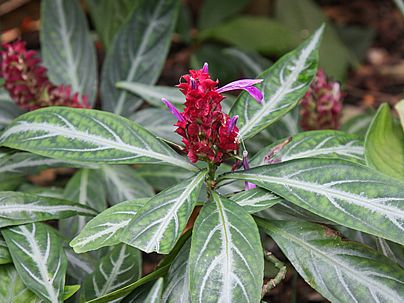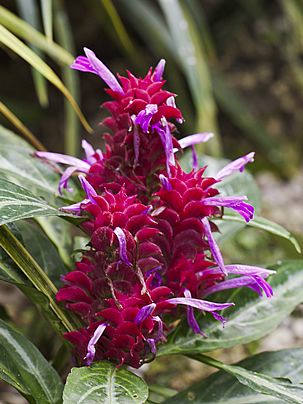The Purple Shrimp Plant (Justicia scheidweileri) is a herbaceous plant known for its ornamental foliage and flowering, native to the Atlantic Forest. It occurs in the states of Minas Gerais, Espírito Santo, and Rio de Janeiro in Brazil, where it forms dense carpets and natural borders. The plant features a green, erect, sparsely branched stem. Its leaves are dark green, highlighted by silver veins, giving it a striking color. They are opposite, lanceolate, acuminate, glabrous, and leathery.
This plant blooms throughout the year, producing erect, terminal spike-like inflorescences, covered with bright, long-lasting pink bracts. The flowers, emerging between the bracts, are tubular, purple in color, and highly attractive to hummingbirds. The resulting fruit is a dry, dehiscent capsule with four seeds.

Whether in the garden or as part of interior decor, the purple shrimp plant is a versatile and low-maintenance option. With its beautiful foliage and spectacular flowers, it can be used as a shrub in protected beds, as ground cover in tropical woods, alone or combined with other species in winter gardens, or simply adorning a charming balcony, planted in a spacious pot.
This rugged species requires minimal cultural care, such as biannual fertilization and annual pruning, which encourage denser growth. Removing old inflorescences is also recommended to rejuvenate the plant’s appearance and stimulate new blooms. However, leave them on the plant if you wish to propagate it by seeds, at least until the fruits open naturally.
The purple shrimp plant should be grown in diffused light or partial shade, in fertile, drainable soil, enriched with organic matter, and watered regularly during the first year of planting. It thrives in tropical heat and humidity and can tolerate short periods of drought. The ideal lighting condition for this species is filtered light passing through the canopy of trees.
However, it can be grown in well-lit interiors, as well as in sunny areas during the morning, but shaded in the afternoon. Intense sunlight can cause leaf burns. It is sensitive to cold or frost; thus, in subtropical climates, it is advisable to grow it in protected locations, avoiding strong winds. Propagation is through seeds and stem cuttings, which should be rooted in a moist substrate, preferably in spring.


